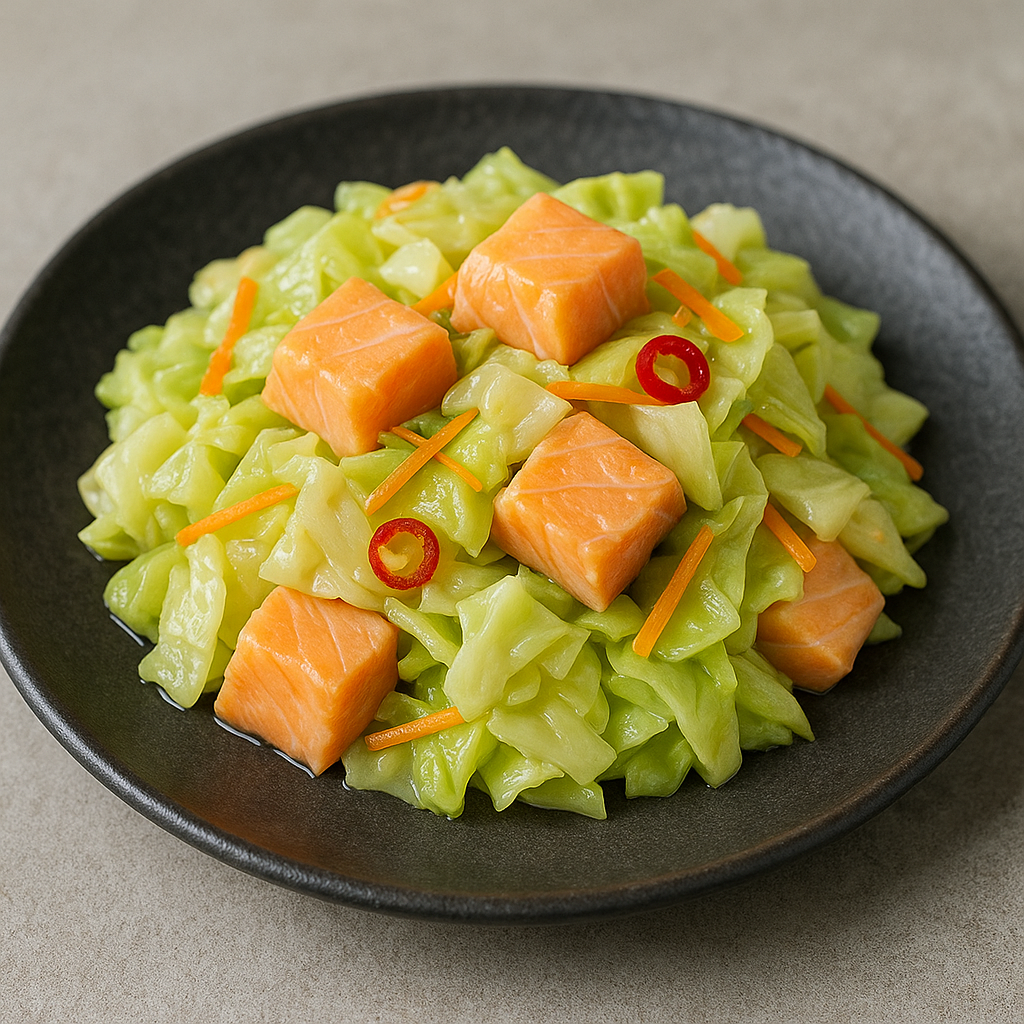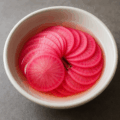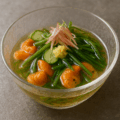キャベツとマスの漬物の特徴
魚の旨みが移る、津軽のさっぱり漬け
塩で下漬けしたキャベツに、酢と酒で下処理したマス、しょうが・人参・唐辛子を合わせて重しをかけ、数日で食べ頃に。魚の旨みが野菜に移り、さっぱりとした味わいが魅力です。
「塩マス×キャベツ」の生活の知恵
内陸の中南津軽では魚が貴重だったため、塩マスやアラまで活用した“無駄を出さない料理”として発達。ご飯にも酒肴にも重宝されてきました。
キャベツとマスの漬物のレシピ
材料(作りやすい量/約4〜6人分)
- キャベツ … 800g(ざく切り)
- 塩 … 16g(キャベツの2%)
- マス … 250〜300g(食べやすいそぎ切り)
- 人参 … 60g(千切り)
- 生姜 … 10g(千切り)
- 赤唐辛子 … 1本(種を除き小口切り)
- 砂糖…適量(味の微調整用)
下処理用(マスのくさみ取り)
- 酢 … 150ml
- 酒 … 40〜50ml
作り方
- 下漬け:キャベツに塩を全体にまぶし、重しをのせて冷蔵で半日〜1日置く(しっかり作るなら2日)。出た水分は捨てる。
- マスの下処理:マスを酢と酒に浸し、冷蔵で一晩(目安)置いてくさみを取る。水気を拭く。
- 合わせる:ボウルでキャベツ・マス・人参・生姜・唐辛子・甘酒をやさしく混ぜ、清潔な容器に詰める。
- 漬ける:ラップを載せてから密着させ、軽い重しをのせて冷蔵で3〜5日。途中で上下を返すと均一に仕上がる。食べる分だけ取り出し、軽く汁気を切る。
シェフのワンポイントアドバイス
- 塩はキャベツ重量の2%が基本。下漬け後に水分をしっかり切ると、味がぼやけません。
- マスは酢:酒=約4:1で下処理。入れすぎに注意し、酸が強ければ甘酒や人参でバランスを。
- 重しは“軽め→様子見”で。強すぎると水っぽくなります。
栄養価(1人分の目安/全体の1/6量)
- エネルギー:約90〜140 kcal
- たんぱく質:8〜12 g(マス由来)
- 脂質:3〜6 g
- 炭水化物:6〜12 g
魚のたんぱく質と野菜の食物繊維を一度に。塩分は下漬け塩と酢の量で調整しましょう。
歴史
魚が貴重だった内陸で育まれた“魚入り漬物”
冬は豪雪、海産物の入手が難しかった内陸の津軽で、塩マスの身やアラを無駄なく活かし、キャベツと合わせた漬物が日常食として定着。ご飯にも酒にも合う“津軽ならでは”の味です。
English Version
Features of Cabbage & Trout Pickle
A light, refreshing pickle from Tsugaru infused with fish umami
Salted, pre-cured cabbage is combined with trout that’s been briefly treated with vinegar and sake, plus ginger, carrot, and chili. Pressed under a light weight for a few days, the vegetables take on the trout’s savory depth while staying clean and refreshing.
Everyday wisdom of “salted trout × cabbage”
In inland south–central Tsugaru, fish was precious. Households made thrifty use of salted trout—down to trimmings—pairing it with cabbage for a no-waste pickle that works both with rice and as a sake side.
Recipe
Ingredients (serves about 4–6)
- Cabbage … 800 g (coarsely chopped)
- Salt … 16 g (≈2% of cabbage weight)
- Trout … 250–300 g (thin bias slices)
- Carrot … 60 g (fine matchsticks; optionally scald with hot water and cool)
- Fresh ginger … 10 g (fine matchsticks)
- Dried red chili … 1 (seeded, thinly sliced)
- Sugar … to taste (for final fine-tuning)
- (Optional) Amazake … 30 ml
For de-odorizing the trout
- Vinegar … 150 ml
- Sake … 40–50 ml
Instructions
- Pre-salt the cabbage: Toss cabbage evenly with the salt, set a weight on top, and refrigerate for ½–1 day (up to 2 days for a firmer result). Discard the expressed liquid.
- Prep the trout: Soak trout in the vinegar–sake mixture in the refrigerator overnight (guide). Pat completely dry.
- Combine: In a bowl, gently mix cabbage, trout, carrot, ginger, chili, and the optional amazake. Pack into a clean container.
- Pickle: Press plastic wrap directly onto the surface, set a light weight on top, and refrigerate 3–5 days. Turn the contents once a day for even curing. Lift out only what you’ll serve and drain lightly.
Chef’s Tips
- Keep the salt at 2% of cabbage weight. After pre-salting, squeeze well so flavors don’t wash out.
- For the trout pre-treat, aim for vinegar : sake = about 4 : 1. If the acidity feels sharp, balance with a little amazake or the natural sweetness of carrot.
- Start with a light weight and adjust as you go—too heavy makes the mixture watery.
Nutritional Value (per serving, ~1/6 of total)
- Calories: ~90–140 kcal
- Protein: 8–12 g (from trout)
- Fat: 3–6 g
- Carbohydrates: 6–12 g
Protein from fish and fiber from vegetables in one dish. Adjust overall salt with the pre-salting and vinegar levels.
History
A “fish-in” pickle born inland where seafood was scarce
With heavy snows and limited access to fresh seafood, inland Tsugaru households made everyday pickles by putting salted trout (even trimmings) to full use with cabbage. It’s a quintessential local flavor that pairs equally well with rice and with drinks.



何でも質問してください!